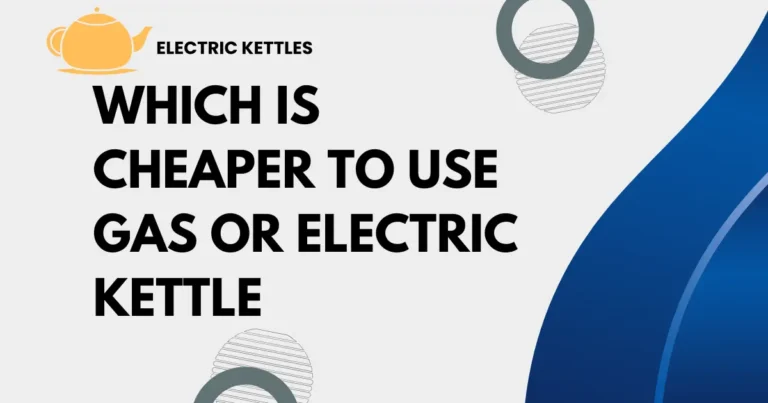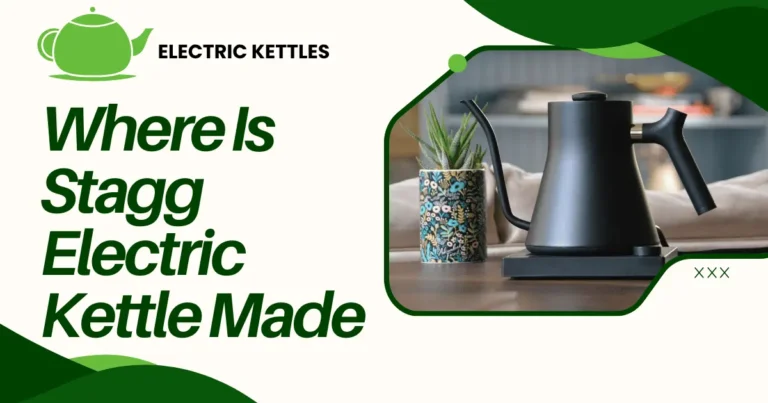Why Is My Electric Kettle Leaking
An electric kettle can start leaking for different reasons. This is a common problem many users face. Leaks can be due to normal wear, damaged parts, or poor handling. Over time, seals inside the kettle may weaken, allowing water to escape. These leaks often occur at the base, lid, or spout.
Identifying the cause of a leak is important to prevent further damage. Small issues, like a loose lid or a worn seal, can be fixed at home. However, bigger problems may need replacement parts or even a new kettle. By understanding why a kettle leaks, you can decide whether to repair or replace it.
Table of Contents
Common Causes of a Leaking Electric Kettle
1. Wear and Tear Over Time
Over time, electric kettles naturally experience wear and tear, especially if they are used daily or multiple times a day. The internal seals, joints, and other components can degrade and lose their ability to keep water contained. Parts made of plastic or rubber are particularly vulnerable, as they may dry out, crack, or lose flexibility, leading to leaks. Regular use accelerates this wear, making it more likely for water to find a way out of the kettle.
2. Damaged Seal or Gasket
The gasket or seal located around the base, spout, or handle plays a vital role in preventing leaks. When these seals become damaged, cracked, or worn out, water can easily seep through, causing noticeable leaking issues. Damage to these seals can happen due to age, improper cleaning, or using harsh chemicals. Regularly inspecting these areas and replacing faulty seals can prevent leaks and keep the kettle functioning properly.
3. Loose Lid or Spout
A loose lid or spout can be another common reason for water leakage. When the lid or spout is not fitted properly, water can spill over, especially when pouring or boiling. A damaged lid that no longer fits snugly may lead to leakage during use. Ensuring these parts are always tightly closed and in good condition can help in avoiding water dripping or spilling out of the kettle. This is especially true when the kettle is tilted for pouring.
4. Cracks in the Body
Physical damage, such as cracks in the kettle’s body, can also lead to leaks. Accidental drops or impacts can create fractures, even if they appear small and hard to see. Over time, these cracks can grow larger, eventually leading to significant leaks. Damage to the body of the kettle is often irreversible, and in many cases, the best solution is to replace the kettle to prevent further issues or safety hazards.
How to Identify a Leak
Signs to Look for in Your Kettle
Identifying a leak in your electric kettle can be straightforward if you know what to look for. Common signs include water pooling around the base of the kettle or on the countertop after use. You might also notice water dripping when lifting or tilting the kettle. Discoloration or dampness near the bottom can also indicate a leak, especially if these signs persist even after careful drying.
Water Pooling and Dripping Patterns
Pay attention to where the water collects or drips. If water is pooling directly underneath, it could be an issue with the kettle’s base or internal seal. Dripping from the spout could mean a loose or damaged lid. Additionally, you can perform a simple test by filling the kettle with water and watching for any visible leakage before switching it on. Observing these patterns can help pinpoint the source of the leak and determine the next steps for repair or replacement.
Possible Solutions for a Leaking Kettle
Tightening Loose Parts
A leaking kettle might have loose components, such as the lid, spout, or handle. Start by inspecting these parts and tightening them if needed. A poorly sealed lid or loose spout can lead to leaks during pouring or boiling. Make sure all parts are properly secured and fitted. Sometimes, simply adjusting or reattaching a loose component can stop the leaking.
Replacing Worn-Out Seals
Damaged or worn seals are a major cause of leaks. If the gasket or seal around the base, handle, or spout is degraded, replacing it can fix the issue. Seals can often be purchased online or from appliance stores. Replacing these seals with new ones ensures the kettle can contain the water properly. Make sure to choose the correct replacement part compatible with your kettle model for an effective solution.
Fixing Cracks with Epoxy
For minor cracks in the kettle’s body, a food-safe epoxy can be used as a temporary fix. Apply the epoxy to the cracked area and let it cure as per the instructions. This can help seal the crack and stop leakage, at least for a while. However, this is not a permanent solution, and replacement may eventually be needed for safe use. It’s best to avoid using heavily damaged kettles to prevent potential electrical hazards.
Preventing Future Leaks
Regular Maintenance Tips
To prevent leaks, regular maintenance is essential. Start by cleaning your kettle after each use to avoid mineral buildup and corrosion. Descale the kettle every few months, especially if you have hard water. Use a mixture of vinegar and water or a commercial descaling solution. Also, check seals and gaskets periodically for signs of wear. Keeping the kettle clean and well-maintained can significantly extend its lifespan and reduce the risk of leaks.
Proper Use and Care
How you use your kettle plays a big role in preventing leaks. Avoid overfilling the kettle, as boiling water may splash out or damage seals. Handle the kettle with care to avoid dropping it, which can cause cracks. Ensure the lid and spout are always tightly secured when using the kettle. Also, avoid using harsh chemicals for cleaning, as they can damage internal parts. By following these simple guidelines, you can help keep your electric kettle leak-free for longer.
When to Replace Your Electric Kettle
Signs Replacement Is Necessary
Several signs indicate it may be time to replace your electric kettle. If you notice persistent leaking despite repairs or a significant decline in performance, it’s a red flag. Other warning signs include frequent overheating, unusual noises during operation, or if the kettle fails to turn on. If the kettle’s exterior shows extensive damage, such as cracks or burns, replacement is likely the safest option.
Choosing a New Electric Kettle
When deciding to buy a new kettle, consider your needs and preferences. Look for features that matter to you, like capacity, boil time, and safety features. Evaluate materials such as stainless steel or glass for durability. Reading customer reviews can also help you choose a reliable model. Investing in a good quality kettle will ensure you get better performance and longevity, making it a worthwhile purchase in the long run.
Conclusion
A leaking electric kettle can be a frustrating issue, but understanding the causes helps. Common reasons for leaks include wear and tear, damaged seals, and loose parts. Identifying the signs of a leak early can save you time and money. Regular maintenance and proper usage can prevent many leaks from occurring.
If repairs do not fix the problem, it may be time to consider replacing your kettle. Persistent leaks, overheating, or physical damage are clear signs that a new kettle is needed. When choosing a new kettle, look for features that fit your needs. Investing in a reliable model ensures better performance and safety.






